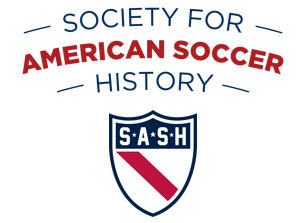Lots of people wonder when American soccer is going to turn the corner, or whether it already has. I don’t think there is any corner. I think progress for American soccer is a continuous, gradual curve. That’s not to say, however, that there haven’t been times when that curve was sharper than others. I think that a very important such time, although one without the fame of 1994 or 2002, was 1991. Consider these events in that year:
- On July 7, 1991, the United States won the first CONCACAF Gold Cup, beating Honduras on penalties in the final after a 0-0 tie. The victory in Los Angeles gave the United States the most significant international trophy it had ever won. The listless final was not a surprise. The Americans were still recovering from their big effort of two days earlier, when they had achieved a 2-0 upset over Mexico in the semifinals on goals by John Doyle and Peter Vermes, and both teams were at the end of a tournament in which they’d played five games in just nine days. The hero for the American team was goalkeeper Tony Meola, who saved three shots in the penalty shootout.
- On Aug. 13, 1991, the United States, fielding its Under-23 team (as did all the entries), won the gold medal in soccer at the Pan-American Games, beating Mexico by 2-1 in the championship game in Havana, Cuba, on goals by Claudio Reyna and Joe-Max Moore.
- On Aug. 16, 1991, the United States beat the host nation, Italy, 1-0, in its opening game of the Under-17 World Cup, on a goal by Mike Dunne. The United States went on to reach the quarterfinals (where it was eliminated on penalties), after sweeping through the first round with victories over Italy, Argentina and China.
- On Nov. 30, 1991, the United States won the first Women’s World Cup, defeating Norway by 2-1 in the championship game in Guangzhou, China, on two goals by Michelle Akers. The Americans outscored their six opponents in this World Cup by 25-5, after having outscored their five opponents in qualifying by 49-0.
- In the spring of 1991, American players began having more effect on European club soccer than they’d ever had before. Americans with pro clubs in Europe in the 1990-91 season included John Harkes and Kasey Keller in England, Paul Caligiuri in Germany, Tab Ramos in Spain, Steve Trittschuh in Czechoslovakia and John Doyle in Sweden, all of them veterans of the 1990 United States World Cup team. Harkes had the most noteworthy accomplishments of the group that spring. He was an important part of Sheffield Wednesday’s campaign as it gained promotion to the English first division and he also became the first American ever to play in a major Wembley final, Sheffield Wednesday’s victory over Manchester United in the English League Cup final. Earlier that season, Trittschuh, who was with Sparta Prague, had become the first American ever to play in the European Champions Cup.
American soccer obviously still had a long way to go after 1991. It still does. But the events of 1991 included some important steps in the right direction.

Very interesting. I didn’t know the importance of this year in US soccer history .